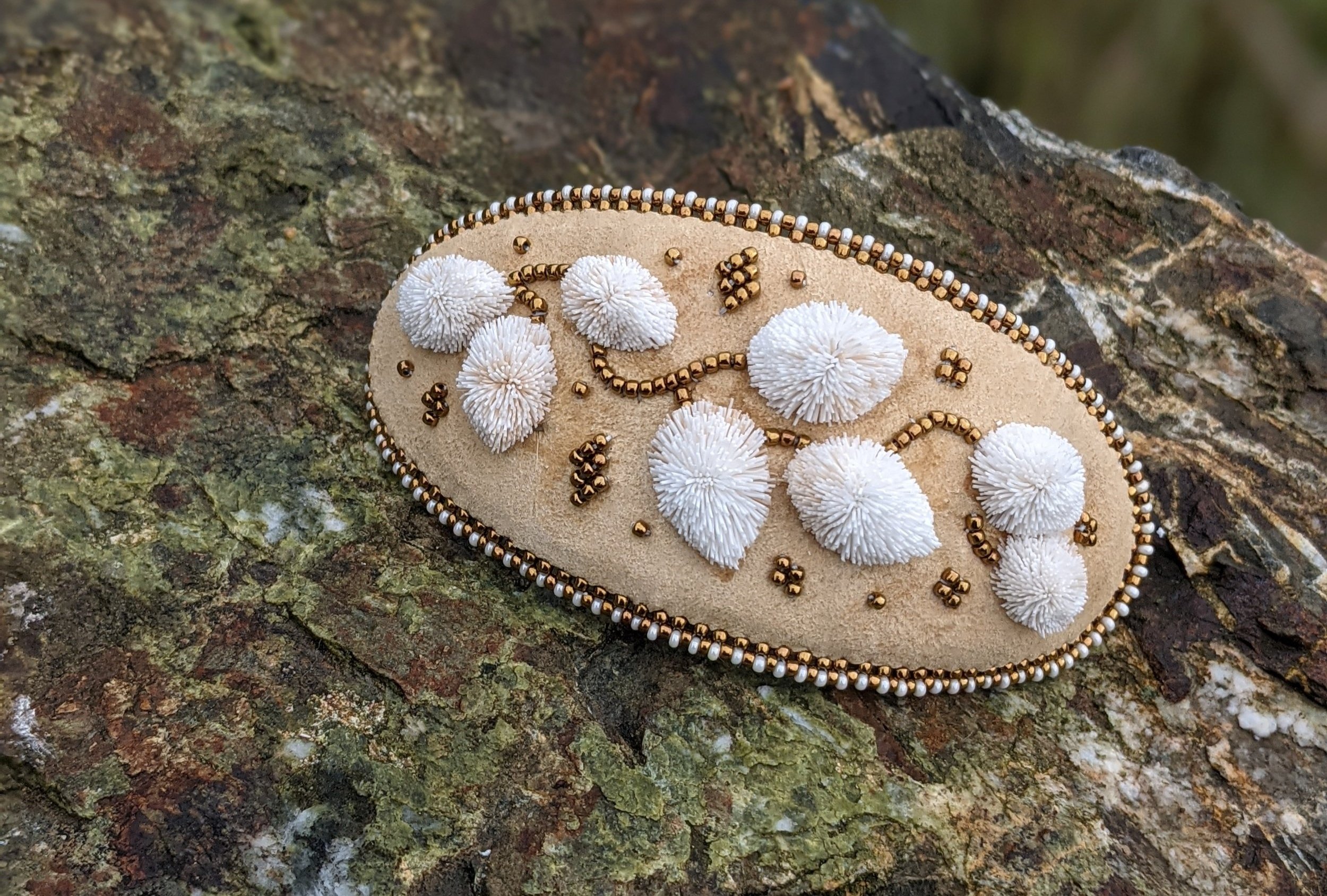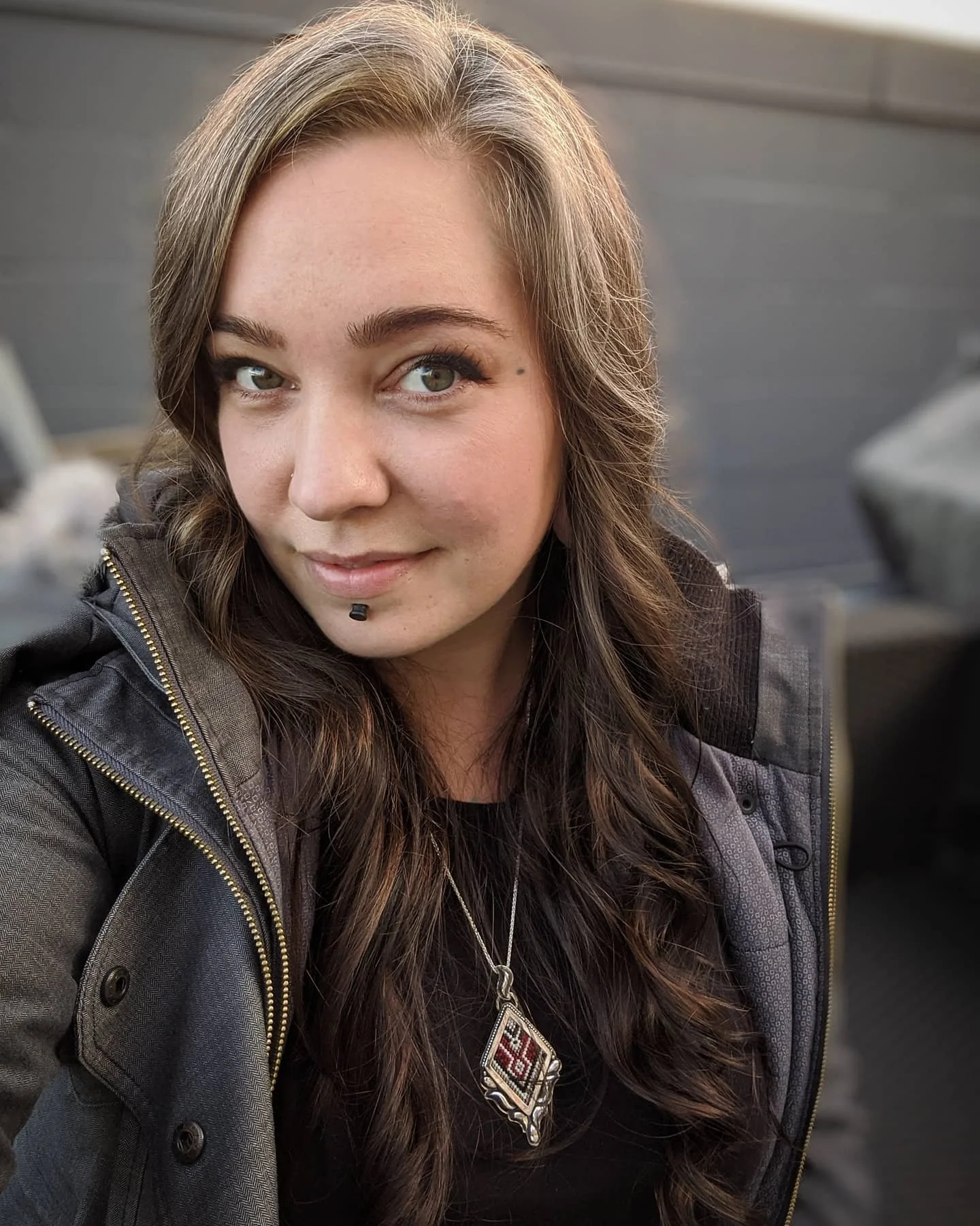
WELCOME TO INDIGENOUS NOUVEAu
TaanisHii Kiyawow! Kaija Heitland dinishiikashoon. Aen Michif niya, Vancouver Island dooshchiin.
My name is Kaija Heitland and I am a Métis woman living on Vancouver Island, on the traditional lands of the Cowichan tribes. I belong to the Cowichan Valley Métis Community, though am originally from Northern Ontario. The Métis side of my family comes from the Hodgson and Denault lines
. My other lineage is Sami, Scandinavian and German.
I have been professionally doing graphic design for 10 years, tattooing for over 15, as well as a lifetime pursuing my traditional skills in beadwork and quillwork and the connections that they have to land-based practices. I am also a silversmith and I focus on using teeth and claws, by-products of Indigenous Hunting traditions, to create one-of-a-kind totemic pieces for my clients while highlighting the need for Indigenous voices in the dialogue for conservation and wildlife management and Indigenous food sovereignty.
In all my work, I focus on the need to reconnect to our traditional arts as a method for self-reclamation and strengthening our community bonds. These investigations into ourselves are essential to the preservation and evolution of Metis art and I focus on many different avenues including fabric, ceremonial items, moccasins, jewellery and regalia. I explore animal symbolism, plant medicine, and traditional food plants in my work, as these designs are an important part of our rich Métis culture of storytelling, and the story of our place in the culture of Indigenous British Columbia.
I began my company, Indigenous Nouveau, as a platform to help to facilitate a greater visibility for my community and the Métis who reside in British Columbia, to showcase our unique beadwork and quillwork patterns, arts culture and history. We are experiencing a renaissance in both our appreciation and our approach to our traditional arts and I find that truly exciting. We, as a culture, are waking up and feeling our strength and vitality and it is wonderful to see that expressed in the art and music being created presently.
In the past few years, I feel as though I have found my true calling in education, sharing and in arts communication. Currently, my main focus has been teaching traditional land-based arts, giving instruction on beadwork, quillwork and the teachings of the Ribbon Skirt and how to incorporate these teachings into our daily paths.
Ki’nanaskou mitinowow!
Maarsii,
Kaija
Artist Statement and Expanded CV
2022 Graphic Design Pricing and Protocol
For updates on my current projects, classes and beadwork kits, please follow my work on my Instagram @indigenousnouveau and Facebook, www.facebook.com/IndigenousNouveau. To see my jewellery, please visit my Instagram @bythethorne.
Indigenous Nouveau - The Story
The Art Nouveau movement of the late 1800’s was aimed at modernization, but more than that, reviving historical art styles and techniques that had fallen out of fashion. It was a resurgence. A Renaissance.
This is the premise of Indigenous Nouveau, a concept for a Métis Arts movement celebrating the presence and artistic diversity of the Métis in Western Canada. We are experiencing a rebirth. Our culture is undergoing a revival of in our art and traditions, inside and outside our community.
The work that I do, the beadwork I create and the fabrics I design are for everyone, and reflect modern Métis culture that finds itself in a new place it is yearning to find strength in its artistic identity.
Now more than ever, It’s so important to find common threads that connect all of our communities whether they are Indigenous or settler, and regardless of culture and race. We all live here, and can only find a way through by focussing on our strengths and similarities, rather than our differences.
The teachings of the ribbon skirt is something I strongly focus on to help to illustrate the connections between the Métis, First Nations and Settlers. We all share this piece of clothing. It is found all over Turtle Island (North America.)
The design for the modern Ribbon Skirts is from many sources. The long skirts and modern materials from Europe that our European Ancestors brought, mixed over the generations with the traditional t-dress and buckskin skirts of the Plains and they were adapted it to our designs, colours and materials. We share so much history with each other and so many commonalities. Through my work, I hope to bring awareness to the need for reducing lateral violence and focus on the aspects of all of our cultures that bring us together instead of separate us.
If you are interested in learning more about the Teachings of the Ribbon Skirt and to learn how education for everyone on Indigenous traditions help to bring us closer to our common goals, please visit www.theribbonskirtproject.ca (Website coming soon!)
Please stay tuned and check in on The Journal Page to see updates about the projects that I’m able to do in our community now with your support. If you have a special community, school or public project that you would like me to participating in, please contact me and I would happily discuss your ideas. If you’re an Indigenous entrepreneur and you would like to reach out or if you need assistance with your business, please send me an email via the form on the contact page.
The MÉTIS in british columbia
“My people will sleep for one hundred years, and when they wake, it will be the artists who give them their Spirit back.” - Louis Riel, July 4th, 1885
The Métis make up 33% of the current Indigenous population of British Columbia, totalling more than 90,000 recognized members, though our numbers are not represented in the current Indigenous conversation in art, culture or education here. It is a passion of mine to bring a little bit of my culture to the forefront through my art and teaching, and using land based practices to strengthen our community bonds.
For the Métis, this under-representation has led to a wide-spread misunderstanding of what Métis culture actually is and what we represent.
We are a distinct, vibrant community of people who are descended from both European and First-Nations people with our own music, stories and history. We celebrate both our lineages. Our fur-trading ancestry helped build and carve this country, making us both colonizers and the colonized. This is a hard concept that many of us struggle with, but find strength and reinforcement in our communities.
We are both the old and the new, meaning that we bridge a gap between the past and the present, which can make us essential to the Indigenous dialogue in this country as mediators and facilitators.
Our membership is voluntary which means that we have to want to participate actively in our communities and culture. We must pursue our culture, our roots and seek actively recognition within a community. These are the things that make us strong.
I have always been saddened by the lack of representation of our Métis people here in British Columbia, most notably, that our Indigenous Museums that I so loved, did not possess a single piece of Métis beadwork, embroidery or history in this province spanning hundreds of years. No one was telling the story of our relationships with the First Nations here, our trade routes, our intermarriages or the collaborative societies that we belong to. It was as if we had been removed from the conversation, though we have contributed to hundreds of years of culture and social evolution in this province.
I want to be part of this conversation. I want to help create a platform to have other Métis artists promoted and celebrated without infringing on the long fough-for recognition of First Nations in the Arts, on their land. (Through all of this, it is important that it is understood that we do not wish to take way from the First Nations of this land where we now call home. We do not make land claims, we do not redirect funding, and above all, continually acknowledge the unceeded territories that we reside on.)
I love reading and hearing stories of our lineage, arts and history but there is a dissonance for me, as I did not grow up in the Métis homeland, the Red River Basin. I feel like my modernized and refreshed approach to beadwork and design is an homage to the more traditional and inherited designs from our lands further East. I wanted to make my designs relevant to the new, 21st century Métis culture that I belong to and a representation of a mixed a displaced peoples in a new land.
Tradition, iconography and symbolism are essential to representing ourselves as Métis, and I believe that a contemporary and modern approach is an appropriate way to represent our journey here from our traditional lands. Although we are fiercely and proudly Métis, descended from long lines of tradition keepers with a distinct culture, in a new place we become a new people, influenced by the plants, animals and pre-existing cultures of that new place that we call home. Our Arts and culture should reflect the changes that we have experienced as a people in our migration from our original homeland, because for me, without innovation and evolution, art dies.
This is Indigenous Nouveau. A rebirth, a resurgence and a celebration of those taking our Métis arts and Culture into the future. This is an opportunity to educate the public to our presence and individuality, and reinvigorate our social bonds with other Indigenous nations through art and culture but highlighting our similarities and historical bonds.
“Heart Flowers”
Copyright 2020 Kaija Heitland






